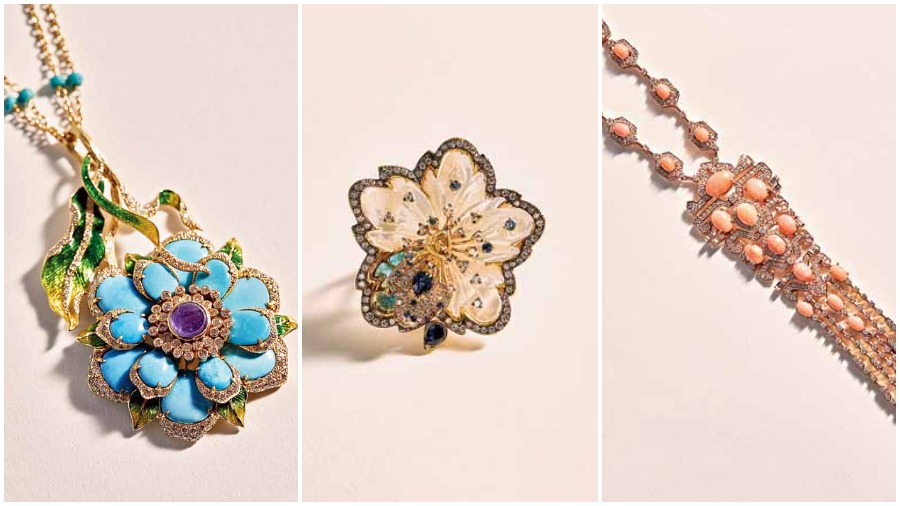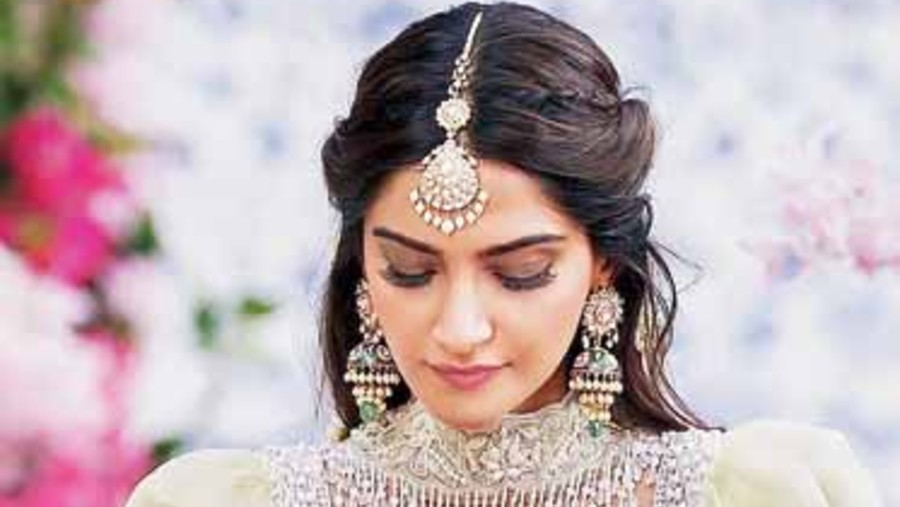Both statement-y and subtle, jewellery designer Sunita Shekhawat’s Bijou Bijou is full of romance and allure. The genial designer who believes that inspiration can be found anywhere —from the “minty green of the imambaras” to the blue pottery of Turkey, chatted with The Telegraph on the making of the special collection, the creative liberty it gave her and stepping into silver jubilee with her brand.
The name ‘Bijou Bijou’ sounds enchanting…
It’s all French!
And, it looks beautiful, colourful and intricate…
All my collections are inspired by colour. I belong to Jaipur and it is such a colourful city. I have grown up in Jodhpur where I would go to these glass bangle shops and then there is this famous dyer in Jodhpur who has also won the Padma Shri and is known for his merging of colours. So, colour occupies the most space in my mind too. You have to train your eyes to understand different shades of colour. You can measure the weight of gold, the hardness of a stone, specific gravity, but you cannot measure a colour. I have worked on more than 350 shades of colour. When we do a kundan-meena collection, it is either a slightly darker or lighter red. The mixing of the alloy defines the purity of the colour. When we do plique a jour, French enamel, in red, I’ll have 20-25 shades. Even in purple, lime green, pink, I have the liberty of using different shades. I used kunzite stone, which is slightly pink and purple and combined it with dark green moss colour of enamel.
Even the most expensive stone cannot match the brilliance of colour, which enamel can give you. It was like an artist’s palette. The range is varied. You can wear it during the day and evenings too.
How can women incorporate jewellery in their everyday lives, now that a lot of us are working from home?
If you are going for a Zoom meeting, you’d like to wear something which is simpler. If you are going out in the evening, go for something eye-catching. The person remains the same. The demand changes as per the occasion. Somebody would definitely love to wear Sunita Shekhawat for the wedding, but what about the parties or a daytime function? So, we are trying to give solutions with different categories of work. Art and craft takes a forefront in whatever we do.

A glimpse of the ‘Bijou Bijou’ pieces Sourced by the correspondent
Flowers are intrinsic to your collections…
When the Mughals came to India, they missed jo peechhe kahani chhor ke aaye the. They tried to create that on a canvas. Certain kings also introduced the shikar theme, but mainly it’s floral.
What are your favourites from the collection?
Turquoise has always been my favourite colour. I love that combination of turquoise and green. It is a little different, but I love the combination.
It’s been a long journey for you, nearing 25 years. How are more and more women buying their jewellery?
It has got to do something with their aesthetics. A woman with a discerning eye and taste would definitely want to buy something that has a lot do with craft and culture. I never try to push my ideas on a client. At times, they are more aware of what they are buying, which is a great learning for me as well. You have to be open-minded. We make beautiful pieces, but it’s you who makes it special. It is a combined effort.
Have how women buy their jewellery changed over the years?
Little bit. It is again a personal choice. The celebration is not about the designer. It is about their happiness that has become important. We help them realise their dream.
Do you have Bengali brides going in for kundan-meena?
It is universal because it goes so well with Indian attire. I have been doing my solo, by-invite exhibition in Taj Bengal for the last 20 years. Businesswise, Delhi, Bombay and Calcutta, barabar kaam hota hai. Calcutta is my favourite city.
Do you have pieces from Calcutta?
When I was in Calcutta for the first time, I heard some of your karigars do lovely meena. I went to see it. This is well-known in the industry too that jo gold pe polish Calcutta mein hoti hai, you won’t find it anywhere. Gariahat, kantha, Flurys… I love them.
What has been your journey like? How has it evolved?
Craftsmanship has been the core of the brand. Even if I do a diamond set, there has to be a Colombian emerald or Burmese ruby or aquamarine or kunzite. Colour takes the lead. Lotus has been a favourite. The next collection will be on carnations.
Can you delve deep into a woman’s personality based on her jewellery?
The way she holds a piece narrates a lot about her personality. Just because you can buy jewellery doesn’t mean you love jewellery. We want people who can appreciate jewellery. It doesn’t matter if you can’t buy it. Even if you buy a small pair of earrings, it’s fine. It’s your passion and how hard-earned your money is. Hai na? I don’t want to sell a heavy-duty piece to someone who doesn’t understand the amount of effort gone into making that piece. My father was in the defence and for us less is always more.
What are bridal kundan-meena must-haves?
I would recommend a choker. Pair it with studs or jhumkis. You can wear it with high-collar pieces or your westerns. (For the D-Day), choose sensibly. Think of layering. We do a lot of reversible pieces. If I do a midnight blue in front, I would put light mint or turquoise, for the daytime.
Sunita’s favourites...
I like Sonam’s (Kapoor) style of wearing jewellery
Rajmata Gayatri Devi. Iconic. Even with a single string of pearls, she used to look gorgeous
Princess Diya Kumari

